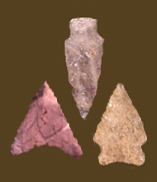
|
SELBY BAY/FOX CREEK
The Selby Bay/Fox Creek point has a broad, lanceolate blade with weak shoulders, a square stem or no stem at all, and a concave base. A side notched variant has also been described. Chronology The Selby Bay/Fox Creek point is associated with Mockley pottery from the Middle Woodland period, generally dated to 200 to 900 AD. However, recent evidence suggests the Mockley phase may have begun earlier; for example, a sherd found at Point Lookout in St. Mary’s County was directly dated to 2030 +/- 40 BP (roughly 10 AD in calendar years), and Selby Bay points were also recovered at this site (Robinson and Bulhack 2006; Sperling 2008). In Maryland’s Western Shore and Piedmont regions, Selby Bay/Fox Creek points are associated with the Selby Bay phase of the Middle Woodland period; on the Eastern Shore, they have been linked with the Carey complex (Wright 1973; Curry and Kavanagh 1991; Lowery 1992). Description Blade: The Selby Bay/Fox Creek lanceolate variant has parallel sides that then taper from the midpoint to the tip, or a triangular blade with straight edges. The stemmed and side notched variants have an ovate or triangular blade with straight or excurvate edges. Haft Element: The base is usually slightly concave, but can be straight or slightly convex. The stemmed variety has a wide stem, with small, right angle or sloping shoulders. In many cases the shoulders are almost non-existent, thus the stemmed type blends into the lanceolate type. The side notched variety has shallow notches. Occasionally the base is thinned. Size: Length typically ranges from 25 to 89 mm, but can be longer. Width ranges from 24 to 40 mm. Thickness ranges from 6 to 11 mm. Technique of manufacture: Soft percussion, followed by pressure flaking. Materials: Selby Bay/Fox Creek points in the mid-Atlantic region are notable for commonly being made from Piedmont rhyolites. In a sample of 753 Selby Bay/Fox Creek points from the lower Patuxent drainage, Steponaitis (1980) reported that 92% were rhyolite, followed by quartz (3%), argillite (3%), chert/jasper (1%), and quartzite (1%). In the area surrounding Zekiah Swamp on the lower Potomac, Wanser (1982) found that 85% of 78 Selby Bay/Fox Creek points were rhyolite, with 6% quartzite, 5% quartz, and a few slate and chert. Stephenson and Ferguson (1963:140) report that the 116 points at the Accokeek Creek site in Prince Georges County were mostly “dark gray argillite or gray slate,” with a few quartz, quartzite and chert examples. Given the norm for Selby Bay/Fox Creek points elsewhere in the region, it is possible that gray material at Accokeek Creek is actually rhyolite. In the Monocacy River drainage, 83% of 517 Selby Bay/Fox Creek points were rhyolite, with 8% quartz, 4% quartzite, 2% each of chert and argillite, and less than 1% of jasper and slate (Kavanagh 1982). In the middle Potomac Valley, materials other than rhyolite are rare (Hranicky 2002). In Delaware, 95% of the points are rhyolite, with argillite sometimes used, particularly to the north (Custer 1996a). Discussion Not all researchers acknowledge a side notched variety of Selby Bay/Fox Creek (Hranicky 2002). However, in Southern Maryland, it is the most common of the three varieties, and its presence has been noted elsewhere in the state, so we include the variant here (Steponaitis 1980; Wanser 1982; Sperling 2008). The Petalas Blade is a large, lanceolate biface that has morphological similarities to the lanceolate Selby Bay/Fox Creek point, and the two are often found in association. Petalas Blades were defined in New York, where they are most common, but they have been recovered in Maryland, particularly on the Eastern Shore, often in caches and mortuary contexts (Funk 1976; Custer 1989, 1996b). Defined in Literature Other Names Used Fox Creek; Steubenville References |
![]()
Search by Shape:
(See Projectile Point Typology) |

|
Thank you for visiting our website. If you have any
questions, comments, Copyright © 2002 by |

|

 Defining Attributes
Defining Attributes